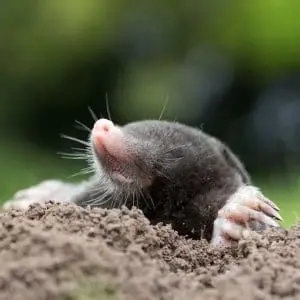If moles are making a home in your yard, you will know it. The underground tunnels they make damage plant and grass roots, and simultaneously create an eyesore of furrows, holes, and dirt mounds above ground. After all of the time and energy you’ve put into your yard, it’s frustrating to say the least. But there are ways of preventing moles from invading your lawn. Read on and find out how to stop the devilish diggers.
Meet the Mole: Identification
Although they are often mistaken for voles and gophers, moles are not members of the rodent family, just odd-looking mammals. These elusive creatures are difficult to identify because they spend most of their time underground. They dig day and night in search of food like worms, grubs, and other subterranean insects.
Brown or dark gray in color, these mammals have long pointed snouts and tiny eyes and ears. They are approximately six-to-eight inches long and weigh up to a pound. Wide and long-clawed, the front paws are used like shovels to dig holes.
Signs and Symptoms of Moles and Mole Activity
As moles create underground tunnels below the soil’s surface, they leave behind a trail of raised ridges and dirt mounds. That is the first sign of a problem. Moles are solitary creatures, so even though the mess they make looks like the work of a family of shifty-eyed shovelers, it is usually the work of only one. Although they stay mostly underground, you may spot one during warm, wet weather.
Besides the devastated appearance of your lawn after a mole has moved in, the messed up turf is difficult to mow. And it’s more prone to weed infestations because of bare spots in the grass. Root damage from underground tunneling eventually takes its toll on plants and grasses.
Getting Control over Moles
These pests are partying it up under your lawn for a reason—they found food. So the first step in managing your mole problem is to get rid of the food source. Although you can’t rid your lawn of all insects, you can do something about your grub population. Use beneficial nematodes or spray milky spore on your lawn. Or consult a lawn-care expert to apply a chemical treatment.
The best solution—and most challenging—to a mole problem is trapping. There are humane traps that allow you to catch the critters unharmed and release them away from your property. Above and below ground traps can be purchased at a local garden center. Follow the instructions and move the trap around until you get your mole.
There are plenty of options for baiting and poisoning if you can deal with death. But preventing moles from permanently making a home in your yard is easier. Many products you already have on hand are natural repellents. Sprinkle cayenne pepper in the tunnel entrances. Tobacco, coffee grounds, and castor oil also work well, but remember to reapply after it rains. Roofing tar is also an effective repellant but can be messy to use.
Preventing Moles in Your Yard
A healthy, pest-free lawn is the first step in preventing moles from moving in. Because these creatures prefer moist soil conditions (damp, loamy dirt makes for easy digging), avoid over watering or choose a grass type that requires less water. Quickly fill in any holes and press down raised ridges.
Preventing moles from damaging your lawn takes time, patience, persistence, and know-how. If you are short on any of these, call in a professional. Contact Free Spray Lawn Care today at 419-529-5296 and we will get rid of any pests once and for all.



Comments (0)
Thanks for your comment!
Thanks for your feedback! Your comments have been successfully submitted! Please note, all comments require admin approval prior to display.
Error submitting comment!
There is a problem with your comment, please see below and try again.